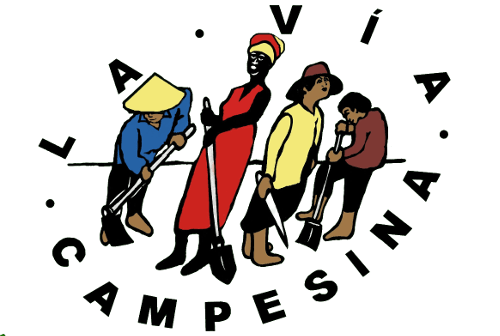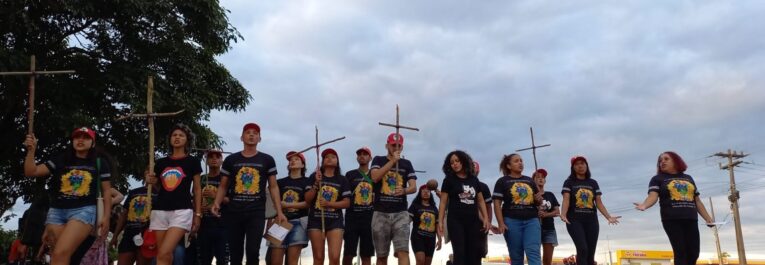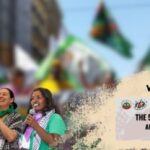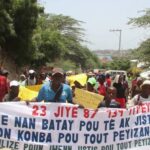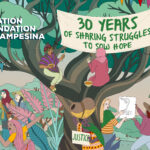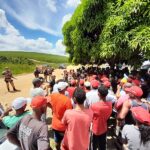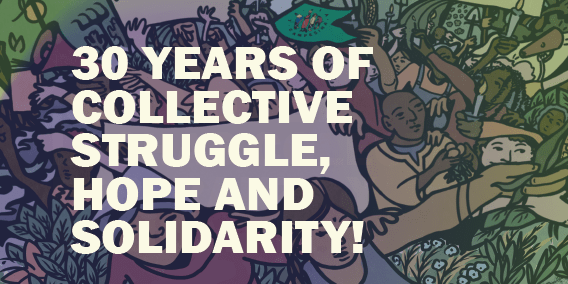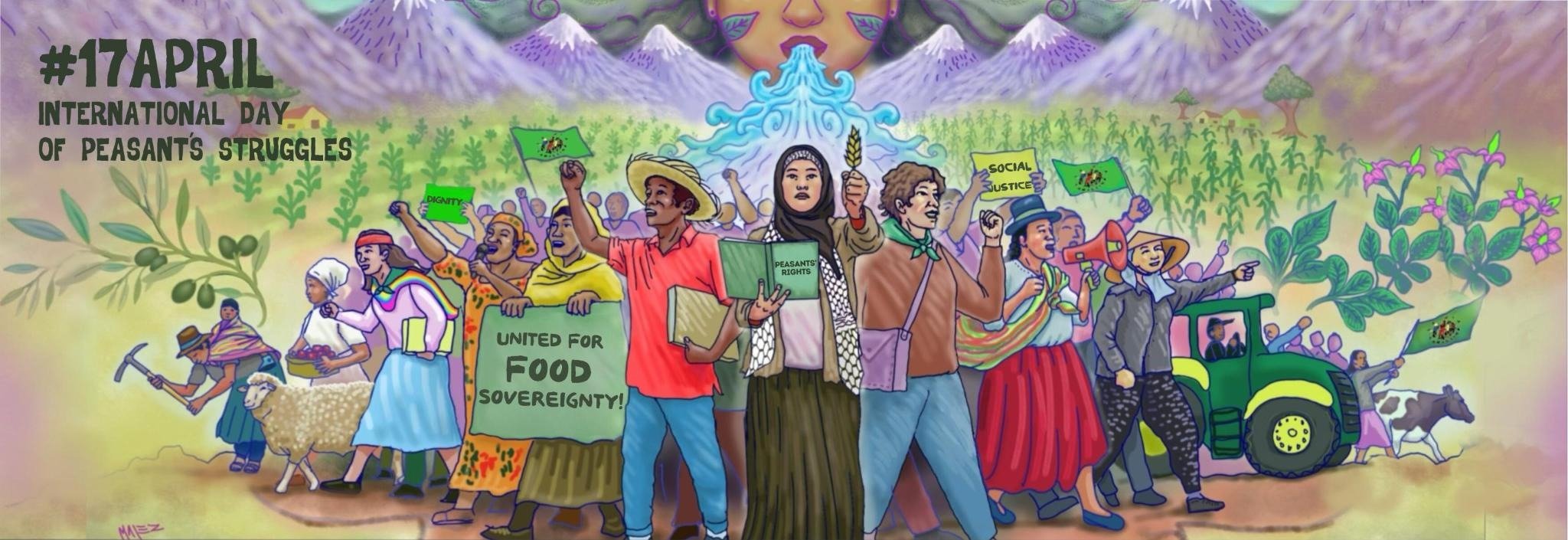April 17, 1996, will be always remembered by the families of the Brazilian Landless Workers’ Movement (Movimento dos Trabalhadores Rurais Sem Terra – MST) as a day of mourning and struggle known all over the world due to the Eldorado do Carajás Massacre, in South Pará. The episode was one of the most violent crimes perpetrated by the Brazilian government against peasant families and remains unpunished, but it is remembered each year by social movements and organizations.
On that day, in the place known as the S-Turn (Curva do S), in Eldorado do Carajás, about 15 Landless rural workers blocked the PA-150 road on kilometer 95 to protest for transportation and food. They intended to march to Belém, the state capital, to demand the expropriation of the Macaxeira farm, where 3.5 Landless families had settled in 1995.
But about 155 military police officers were authorized by the state governor Almir Gabriel, from the Brazilian Social Democracy Party (Partido da Social Democracia Brasileira – PSDB), to attack the Landless workers during the demonstration. This led to the assassination of 21 rural workers connected to the MST who were participating in the protest. Nineteen of them died at the scene and other two passed away later in hospital.
After the Massacre, La Vía Campesina has commemorated April 17 as the International Day of Peasant Struggles in memory of the martyrs of Eldorado do Carajás who were fighting for the right to land and to life and who were brutally murdered by the Brazilian government. Every year, in the week around April 17, the MST also conducts the National Day of Struggle in Defense of Agrarian Reform. This year its motto is “Occupy to Feed Brazil!” and it will last until late April.
Maria Zelzuita Oliveira de Araújo, 59, survived the Massacre and nowadays lives in the April 17 Settlement, in the city of Eldorado do Carajás. She remembers the aftereffects of the crime and tells us about the way the life of her family changed after conquering their land.
“First the Massacre caused sadness and anger, indignation for losing so many people. But I have also conquered my land, my house, my job, and raised my family. Before I knew the MST, I had nothing, I was a maid and lived at my employers’ house and I was a cook at a restaurant. After I found the MST, my life improved. As did the lives of the 690 neighbors who live here in the April 17 Settlement. Read her full testimony below.
Violence and impunity in rural areas persist
Since then little has changed in Brazil’s context of rural violence. According to a report called Conflicts Booklet (Caderno de Conflitos), published by the Pastoral Land Commission (Comissão Pastoral da Terra), 973 rural conflicts occurred in the first half of 2023, most of which (791) were struggles for land. This represents an 8% increase in comparison to the same period in 2022.
Also according to the report, indigenous populations were the most affected by violence (38.2%), followed by landless rural workers (19.2%), tenants (14.1%), maroons (12.2%), and agrarian reform settlers (5.5%).
This year we remember the 28 years of impunity of the Eldorado do Carajás Massacre, which remains an open wound for the country and especially for the state of Pará, which has alarming rates of violence against peasants. It is a state where agribusinesses keep using violence as their main instrument of repression against the struggle for Agrarian Reform, according to Jorge Neri, from the state-level direction of MST in Pará.
According to him, the families from the MST have learned a lot from their struggle for Agrarian Reform and from the violence they face, especially from the Eldorado do Carajás Massacre. “The Massacre showed us that we should not underestimate the government’s ability to repress and attack us, but also that we should organize the process of mass struggle better”, he explains.
He also reports that to this day the April 17 Settlement has not yet overcome the traumas caused by the Massacre and argues that the Brazilian government must provide these families with reparation. “Our community is still very marked by violence, and we must claim for psychosocial and economic historical reparation by the Brazilian government to the survivors from the Massacre, who still suffer from the consequences of this unfortunate event and go on demanding an end to violence and impunity in rural areas”, states Neri.
Oziel Alves Educational Camp of the Landless Youth
One of the symbols preserving the memory of the martyrs of Eldorado do Carajás and reaffirming MST’s commitment to keeping up its struggle for land is the realization of the Oziel Alves Educational Camp of the Landless Youth in the S-Turn almost every year during the same week in which the Massacre happened.
In its 18th edition, the Camp will be held from April 10 to 17, with the participation of young people from the states of Pará, Maranhão, Tocantins, and Roraima. The activities planned for this period comprise some of the MST’s internal and organizational affairs and function as spaces for formation, struggle, and memory, which include debates about subjects like the current agrarian context and politics, as well as the problems faced by rural youths.
Neri highlights the efforts made by the MST preserve the country’s memory about the Massacre, which explains the realization of the Educational Camp of the Youth since 2006. Every year this event promotes reflections about the real meaning of this case of violence against Landless families and reaffirms the importance of the struggle for land in the region and in the country, to build a society based on the right to land, to life, and to producing healthy food.
Without Agrarian Reform, there is no democracy, and without democracy there is no way to build a society which is able to account for the historic demands of the working class. April brings about another important reflection concerning the urgent need to resume mass struggle for Popular Agrarian Reform as a requirement of a popular project for Brazil, to oppose the current economic model and the growing exclusion it promotes within Brazilian society”, Neri concludes.
Testimony: “The MST gives life to people who have nothing”
After 28, this woman who is also an agrarian reform settler, a solo parent, and a survivor of the Eldorado do Carajás Massacre shares her testimony:
“This is what the Massacre caused: first sadness and anger, indignation for losing so many people.
But I have also conquered my land, my house, my job, and raised my family. It was only God and I as a solo mom. I’ve raised my family. Now my sons and daughters can study.
For us, living in the settlement, after having been settled, we have conquered our lands, our houses. It improved our lives.
(…) Before I found the MST, I didn’t even have a shack where I could live and protect my children. I had nothing. I lived as a housemaid in a family’s house, I worked for restaurants.
But not today. After I found the MST, my life improved, I conquered my land, my house, my job. I have my family. As do the other 690 neighbors who live here in the April 17 Settlement.
I moved to the encampment on November 5, 1995. That was when I found the MST.
I’m still in the MST, working, contributing. I’m a state coordinator and I do whatever I can. I’m very grateful first to God, then to the MST. The MST gives life to people who have nothing. It’s not easy, but it’s the struggle. A struggle that includes achievements.”
This article by by Carlinhos Luz and edited by Solange Engelmann first appeared on MST’s website.
